How To Fish The California Delta | Your California Delta Fishing Report
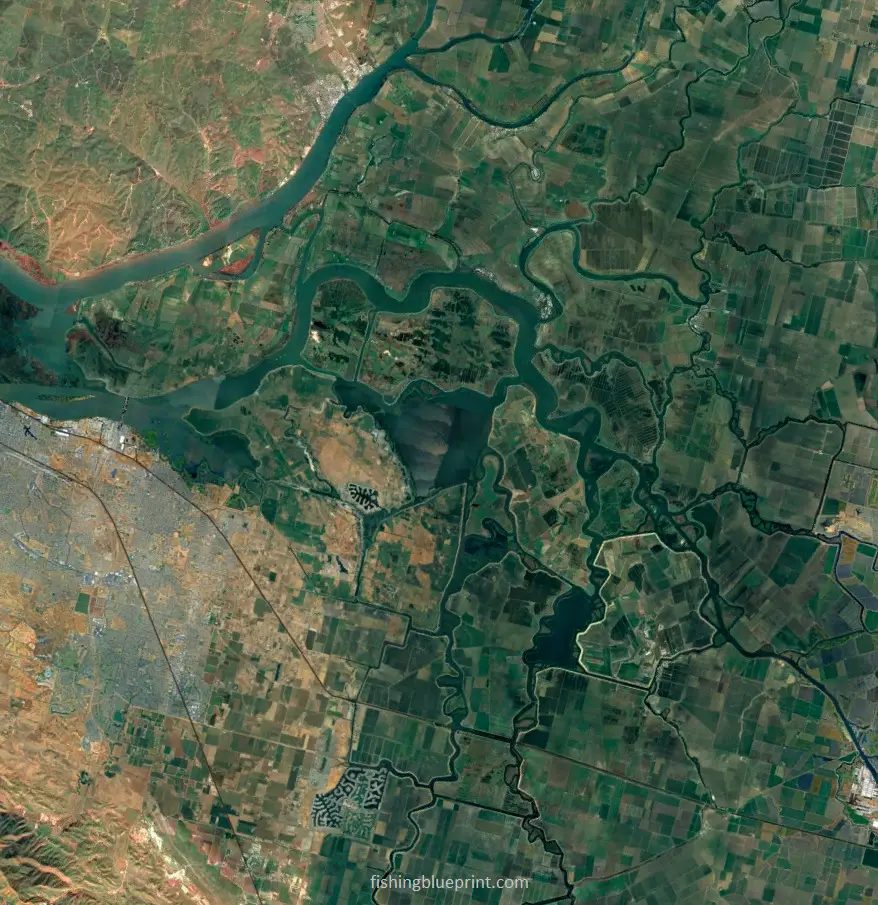
The California Delta (officially known as Sacramento-San Joaquin Delta) is known as one of the best fishing destinations in the United States. It’s located 75 miles away from downtown San Francisco, or 383 miles away from Los Angeles.
Overall it’s a very popular area to fish for largemouth and striped bass. In this post you’re going to be given the blueprint to fish this lake.
So what are the best tips for fishing the California Delta? There are three important factors you must know if you want to know how to fish the California Delta successfully. First, you need to know what kind of fish is in the California Delta. Second, it’s important for you to know which part of the lake each species can be found. Lastly, knowing what are the best baits that work on the California Delta is vital. However, tactics, baits, and locations will be different for each type of fish that you target. So let’s talk about the steps you need to take in order to give you the best chance of catching a fish on the California Delta.
Key Takeaways
This lake gives locals and visitors the opportunity to test their luck in catching one of the many game species this lake has to offer, such as salmon, bass, sturgeon, catfish, bluegill, and much, much more!
Here’s the most recent and updated California Delta Fishing Report – it gives you a quick and easy list of some really good fishing spots. If you’re looking for more detail on how to fish each spot scroll down into the article.
- Franks Tract
- Big Break
- Little Mandeville Island
- Mildred Island
- Medford Island
- Discovery Bay
Here are some additional fast and helpful tips just for you:
- The easiest way to fish this lake is by boat, but there are areas to fish from the bank, or by kayak or float tube.
- There are public boat ramps to use.
- Camping and RV parking is available.
- You can buy tackle and groceries at the lake or at one of the tackle shops listed below.
About The California Delta
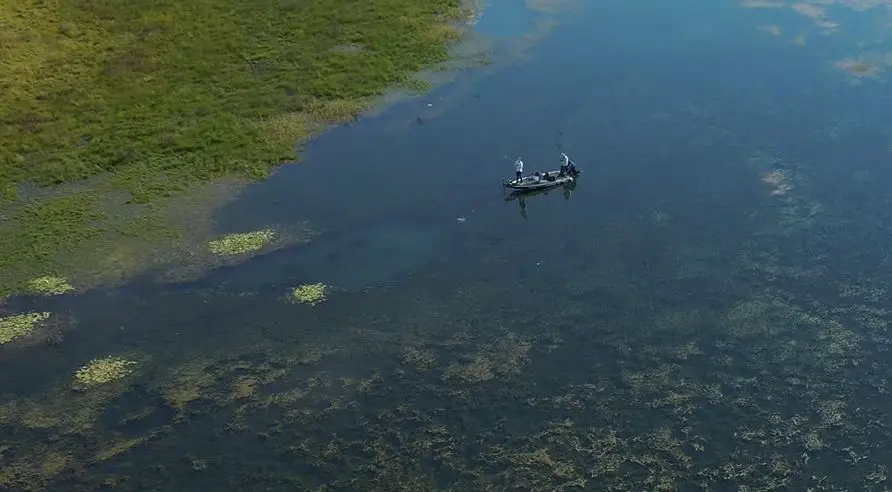
The California Delta is a shallow body of water with the average depth being 15-20 feet and a maximum depth of 30-50 feet deep. The California Delta is an immense area that spans 1,100 square miles and follows the Sacramento river which is 30 miles long.
The California Delta gives locals and visitors the opportunity to test their luck in catching one of the many game species this amazing area has to offer.
Important Lake Warnings
Algae blooms may be present which may affect fishing, swimming, and water contact in general.
According to parks.ca.gov, “every one of California’s new laws requires boat operators to have a California Boating Card. The card is required for anyone under the age of 41 to operate a boat in California’s waters.”
If you are fishing and camping, fire bans may be in effect due to the ongoing drought conditions.
What Kind Of Fish Are In The California Delta
- Striped Bass
- Largemouth Bass
- Smallmouth Bass
- Spotted Bass
- Chinook/“King” Salmon
- Sockeye Salmon
- Rainbow Trout
- Brown Trout
- White and Black Crappie
- Bluegill and Sunfish
- Catfish
- Sturgeon
California Delta Fishing Tips & General Strategies
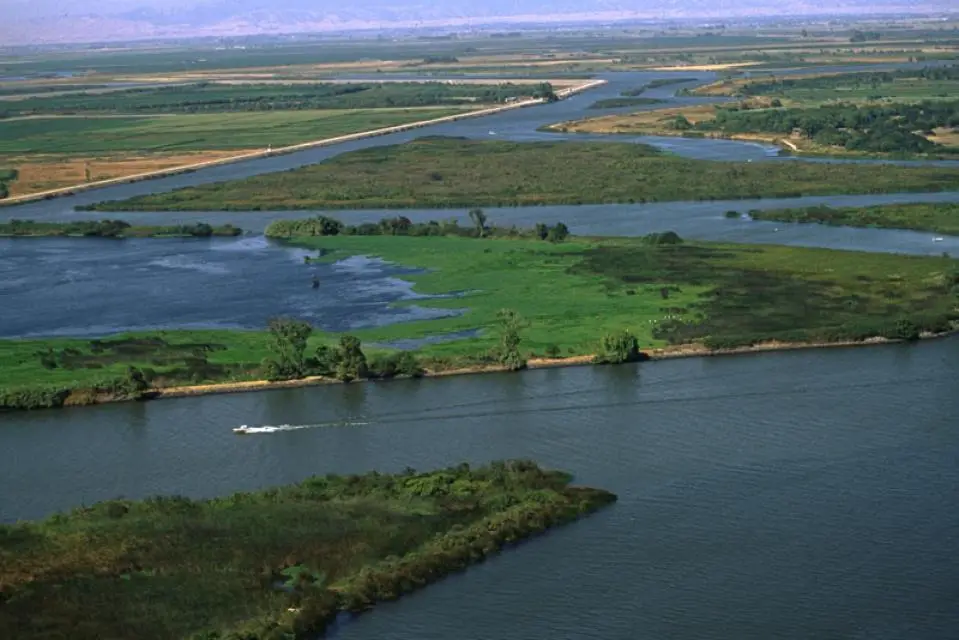
It can be a challenge to break down this body of water… So that’s why I created this California Delta Fishing Report to help you to easily start catching fish fast!
The interesting thing about the Delta is anglers will commonly divide the Delta into 5 sections, Central delta, North, East, South, and West.
Since the Delta is not a singular lake, you have to understand that it is a feeder system, where multiple rivers and creeks will drain into it.
So when fishing the Delta, it’s important to know what’s going on with the surrounding rivers, because that’s going to play a huge part in determining how much dissolved oxygen is in the water, the water clarity (how clear or dirty it is), and the amount of sediment in the water.
Here’s one of the biggest tips I’ll share right now… a good way to give yourself the upper hand on the Delta is to go to local tackle shops, buy some baits, and ask the clerk where they are hearing the average depth clarity of around two and a half to three and a half feet is. Drive around to different shops as well.
Anything more than that the water becomes way too clear and the bass become super selective.
Most guides and tournament anglers prefer the water with just a bit of tint to it. It’s clear enough that bass can see there is something in the water they can eat, but it’s just a little harder to make out what it is… which puts the odds in your favor, right!?
So when you get on the water, motor over to the areas that have these 3 characteristics:
- slightly stained water that is approximately 3 feet of visibility,
- A couple of degrees warmer than the surrounding areas
- Has bright, deep, healthy green vegetation along the banks.
.
Before even considering driving out to the Delta, I strongly recommend buying a good sonar with a map card for the Delta. Being able to rely on a good chart plotter/ GPS unit will save you the hassle of trying to navigate the maze of canal systems that connect the Delta.
Water Clarity: A Fisherman’s Crystal Ball
- A little murky, a little clear: The California Delta’s water clarity is like a mixed bag of tricks. Depending on the season, tides, and weather conditions, you can expect a wide range of visibility.
- Fish on the fly: With changing clarity, you’ll need to be adaptable in your fishing approach. Try out different lures and presentations to find out what works best for you.
- Clear as mud: Though water clarity can vary, you’ll often find murky waters in this delta. That’s where those dark-colored lures come in handy, so the bass can spot your bait from a mile away!
Structures and Cover: Bass Hideouts
In the California Delta, bass love to hide in these gnarly structures and fishing cover:
- Tules: Tangled Up in Green
- Tule time: The Delta’s tules are like an underwater jungle gym for bass. They provide perfect cover for ambush predators looking to score a meal.
- Pitch perfect: Flip and pitch your baits into the tule pockets to catch bass off-guard. They won’t know what hit ’em!
- Weedlines: A Bass Highway
- Weed whackers: Weedlines are the Delta’s superhighways for bass. They cruise along these green corridors, looking for their next meal.
- Spinnerbait sensation: Use a spinnerbait to cover water quickly and target active bass. You’ll be reeling in the big ones before you know it.
- Riprap: Rocky Road to Success
- Riprap rascals: The California Delta has miles of riprap, offering fantastic fishing opportunities. These rocky shores are prime real estate for crawfish-loving bass.
- Just Jiggin’: Toss a jig or a Texas-rigged soft plastic to imitate the crawfish these bass can’t resist. All your boys are going to be jealous!
- Docks: Bass Hangouts
- Dock dwellers: Bass love to chill in the shade of docks. These structures provide the perfect ambush point for a hungry bass.
- Skipping school: Show off your skipping skills by sending your lure under the docks, and watch the bass bite!
Here’s a quick rundown of the weather patterns you can expect during this prime fishing season:
- Air Temperature: Recent reports have been coming in and these spring temps have been warming-up, with temps ranging from the mid-60s to the low 80s (°F). Dress in layers to stay comfortable while you’re reeling in those lunkers.
- Winds: We’ve been finding moderate winds in the Delta, usually around 10-20 mph. Wind direction can vary, so keep an eye on those whitecaps to stay in the strike zone.
- The Wind Factor: With winds afoot, baitfish get pushed into pockets and shorelines. Use this to your advantage by fishing windblown areas—bass will be there, ready for a feast.
- Spring Showers: Rainy days can be hit or miss, but don’t be afraid to get wet. Overcast skies and rain can activate the bite and make for epic fishing sessions.
Let’s talk largemouth and striped bass, and when and where they’re expected to spawn in this incredible fishery.
Largemouth Bass Spawning Season
- Timing is key: Pros and local guides commonly say the largies spawn in the California Delta from late February through May, depending on water temperature and weather conditions.
- Hot spots: Prime largemouth spawning grounds can be found in the Delta’s vast network of sloughs, but some of the best locations we’ve been hearing have been from Frank’s Tract, Big Break, and Little Mandeville Island. The central and southern portions of the Delta, including Mildred Island, Lost Slough, and the San Joaquin River, also hold prime spawning locations.
- Temperature’s rising: Largemouth bass typically begin spawning when water temperatures reach the sweet spot of 60-65°F. Keep a close eye on the water temperature as you fish, because it’s a key indicator of spawning activity.
Striped Bass Spawning Season
- Timing matters: Striped bass spawning in the California Delta usually occurs between April and June, with peak activity happening around May.
- Location, location, location: Striped bass prefer to spawn in moving water. You’ll find them running up rivers like the Sacramento and San Joaquin, as well as their tributaries, such as the Mokelumne and Cosumnes Rivers. The area around Rio Vista on the Sacramento River is a popular spot for targeting spawning stripers.
- Temperature talk: Striped bass start spawning when water temperatures reach around 59-65°F. Be sure to monitor water temps and keep your ears open for reports of spawning activity.
Spawn-tastic Tips for Fishing Success
- Pre-spawn prowling: Target bass in the pre-spawn phase when they’re feeding heavily to bulk up for the spawn. Focus on staging areas near spawning grounds, like flats, drop-offs, and channels.
- Bed fishing basics: During the spawn, look for bass beds in shallow, protected areas with a mix of gravel, sand, and vegetation. Pitch soft plastics or drop-shot rigs to entice protective bass into biting.
- Post-spawn pursuits: After spawning, bass may be lethargic but still hungry. Target recovering fish in nearby deeper water, using slower presentations to coax them into biting.
Summer Fishing Delta update
Summer Weather Patterns
- Air Temperature: Summer temperatures in the Delta can soar, ranging from the mid-70s to the high 90s (°F)… this place can feel like a sauna!
- Stay hydrated and lather on the sunscreen, because the sun will be sizzling!
- Winds: Wind speeds can vary during the summer months, but expect them to be slightly milder compared to spring, typically around 5-15 mph. Wind direction can still change, so stay versatile in your fishing approach.
- Heat Waves: Occasional heatwaves can push temperatures into the triple digits. Beat the heat by targeting bass in deeper, cooler water or fishing during early morning and evening hours.
Average Water Temperature and Fishing Presentations
- Feeling Hot, Hot, Hot: Summer water temperatures in the California Delta can climb into the mid-70s to low 80s (°F). This warmth will impact the behavior of both largemouth and striped bass.
- Largemouth Bass Tactics: As water temperatures rise, largemouth bass will seek cooler water and cover. Focus on deeper structure, weedlines, or shaded areas under docks. Slow down your presentation with finesse techniques, like drop-shot or wacky-rigged soft plastics.
- Striped Bass Strategies: Striped bass may also move to deeper, cooler water during the summer months. Try vertical jigging, trolling deep-diving crankbaits, or using live bait to entice these fish.
Primary Forage for Bass in the Summer
- Largemouth Bass: During summer, largemouth bass in the California Delta primarily feast on bluegill, shad, and crawfish. Match the hatch by using lures that mimic these forage species, like swimbaits, crankbaits, or creature baits.
- Striped Bass: Striped bass have a similar diet, with a focus on shad and other baitfish during the summer months. Use topwater plugs, swimbaits, or jerkbaits to imitate their prey and trigger aggressive strikes.
Reaction Baits
- Strike King KVD Square Bill Crankbait: This crankbait is great for mimicking baitfish and triggering aggressive strikes around structure and shallow cover.
- Booyah Pad Crasher: This topwater frog shines in heavy vegetation like the Delta’s tules and weed mats, calling bass out of their hiding spots.
- Lucky Craft LV-500 Lipless Crankbait: This lipless crankbait is perfect for covering water quickly and tempting bass with its tight wobble and loud rattle.
Slow Presentation Baits
- Yamamoto Senko: Rigged wacky style or Texas-rigged, the Senko is a versatile soft plastic that excels in a variety of situations.
- Roboworm Straight Tail Worm: Paired with a drop-shot rig, this worm will entice even the most finicky bass to bite.
- Zoom Brush Hog: Texas-rigged or on a Carolina rig, this creature bait is ideal for mimicking crawfish and tempting bass around structure.
- Zoom Trick Worm: Loaded on a shaky head this is a phenomenal combination to catch some bass.
- Missile Baits D-Bomb: Locked on a heavy gauge flipping hook with a 1-½ tungsten flipping weight these are great to penetrate those thick mats.
Top 5 Summer Largemouth Bass Hotspots
- Frank’s Tract: This flooded island offers diverse cover, including tules, submerged vegetation, and docks.
- Big Break: The shallow waters and dense vegetation make it a summer bass magnet.
- Little Mandeville Island: With a mix of tules, docks, and channels, this spot offers excellent largemouth bass fishing opportunities.
- Mildred Island: The submerged island structure provides bass with cooler, deeper water to escape the summer heat.
- Lost Slough: This slough features a range of cover and structure, making it a productive summer bass fishing spot.
High Tide Fishing
Fishing for bass in the California Delta during high tide can be a bit of a challenge, but with the right tactics, it can be very rewarding. Here are some tips that you may find useful:
- Look for moving water: High tide often creates moving water which can attract baitfish, and in turn, bass. Focus on areas near tidal channels and sloughs, where the water is flowing in and out.
- Fish cover: Bass will often seek cover during high tide, so look for areas with plenty of aquatic vegetation, trees, or other structure that the fish can hide in.
- Use topwater lures: High tide can be a great time to use topwater lures, such as poppers or buzzbaits, as the moving water can create a commotion that will attract bass to the surface.
- Try deeper water: If the high tide has covered up shallow structures that you usually fish, try fishing in deeper water. Bass will often move to deeper water during high tides, so you may find them in areas that you wouldn’t normally fish.
- Pay attention to the tides: Tides can greatly affect the behavior of bass, so make sure to pay attention to the tidal schedule and adjust your fishing tactics accordingly.
Low Tide Fishing
Fishing for bass in the California Delta during low tide can be a great opportunity to target fish that are holding in areas that are exposed as the water level drops. Here are some tips that you may find useful:
- Focus on structure: Low tide exposes shallow structure, such as rocks, logs, and weed beds, that can hold bass. Cast around these areas and retrieve your lure slowly to mimic a fleeing baitfish.
- Use finesse techniques: During low tide, the water can be clear, and the fish may be wary, so consider using finesse techniques, such as drop-shotting or shaking a worm, to present your bait more naturally.
- Pay attention to baitfish: Look for areas where baitfish are gathering, such as shallow flats or along the edges of weed beds. These areas are likely to hold bass as well.
- Try topwater lures: Low tide can be a great time to throw topwater lures, such as poppers or walking baits, as the fish may be more active in the shallower water.
- Fish the drop-off: As the tide drops, the drop-off from shallow to deeper water can be a good spot to target bass. Fish along the edge of the drop-off and look for fish that are holding in the deeper water.
But Where Are The Best Places To Fish The California Delta?
And in no particular order here is that list of some the best fishing spots at the California Delta.
DISCLAIMER: The material provided is for general information purposes only. It’s important to understand that any information provided in this article can change at any time. Any maps or graphics featured are not to be used as navigational aids. Fishing Blueprint will not be responsible for any personal injury or property damage from any misuse of the maps or graphics provided. It’s completely impossible to give you every single spot where you can potentially catch a fish. But, what this list does do is to give you a helping hand and narrow down to the most productive fishing spots.
Franks Tract
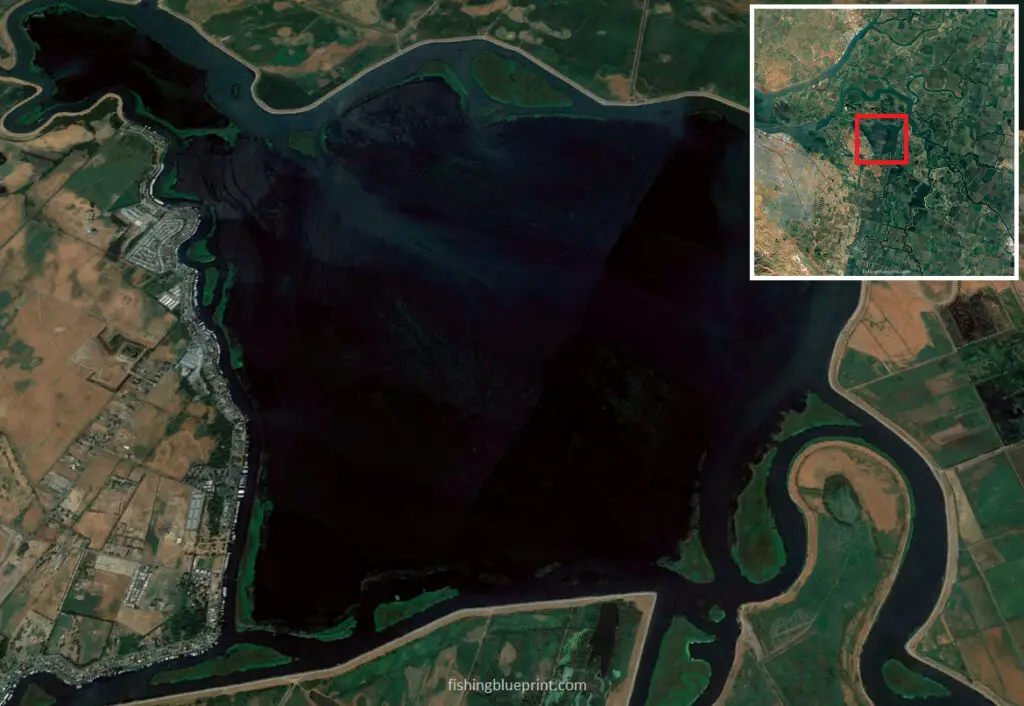
Frank’s Tract is a popular fishing destination on the California Delta and offers a variety of opportunities for anglers to target bass and other species. Be aware, sometimes you can see 200+ boats fishing in this one area.
Here are some tips to help you fish Frank’s Tract effectively:
Look for weed bed edges in low tide and tules during high tide: Frank’s Tract is known for its abundant weed beds and tule lined banks, and these areas can be great places to target bass. Fish along the edges of the weed beds and look for areas where the weeds are thickest.
Focus on sloughs: Frank’s Tract has many sloughs that can hold good concentrations of bass. Fish along the edges of the sloughs, especially where they meet the weed beds, and keep an eye out for any underwater structure, such as rocks or logs.
Main pool humps: Frank’s Tract has many small offshore humps that can hold a lot of big bass. Fish along the tops of these time in high tide and fish the lower edges during low tide.
Look carefully at this spot with the topographic map…

Use topwater lures: Frank’s Tract can be a great place to fish topwater lures, such as frogs, buzzbaits, poppers or walking baits, especially during the low light hours of dawn and dusk. The shallow waters and abundant weed beds can make for exciting topwater action.
Try finesse techniques: During periods of high pressure or clear water, the bass in Frank’s Tract can become wary, and finesse techniques, such as drop-shotting or shaking a worm, may be more effective.
Pay attention to tides: Frank’s Tract is affected by the tides, and the water level can fluctuate significantly. Pay attention to the tides and adjust your fishing tactics accordingly. For example, during high tide, the sloughs may be more productive, while during low tide, the shallower weed beds may be more active.
Structural features: grass, drop offs/ ledges, humps.
Best species to target: largemouth bass
Most effective way to fish this spot: flipping, swimbaits, crankbaits, topwater baits, frogs, poppers, buzzbaits, Senko, wacky rig, drop shot
Big Break
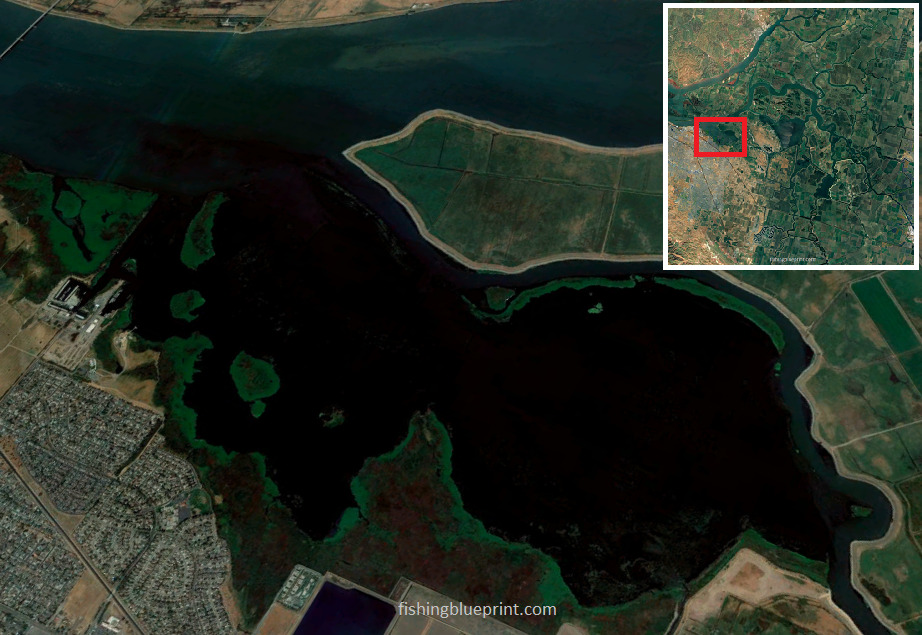
Big Break is a popular fishing destination on the California Delta and offers a variety of opportunities for anglers to target largemouth bass, smallmouth bass, and striped bass. Here are some tips to help you fish Big Break effectively:
Focus on structure: Big Break is known for its abundant underwater structure, such as rocks, boulders, and drop-offs. Fish along these structures and look for areas where the bass might be holding.
Look carefully at this spot with the topographic map…

Use crankbaits: Big Break has deep waters at the mouth and along the adjacent Dutch Slough, so deep-diving crankbaits can be an effective way to reach the deeper areas where the bass might be holding. Target the drop-offs and deeper channels with these lures.
Shallow diving crankbaits and lipless crankbaits are effective in the shallow areas with grass.
Try jigs or worms: Jigs or worms fished along the bottom can be effective in the deep waters of Big Break. Pay attention to any underwater structure and fish these baits in and around these areas.
Pay attention to tides: Big Break is affected by the tides, and the water level can fluctuate significantly. Pay attention to the tides and adjust your fishing tactics accordingly. For example, during high tide, the deeper areas may be more productive, while during low tide, the shallower areas may be more active.
Look for baitfish: Pay attention to any signs of baitfish activity, such as birds diving or schools of baitfish on the surface. The bass will often be feeding on these baitfish, so fishing in these areas can be productive.
Structural features: grass, rocky banks/riprap banks, humps.
Best species to target: largemouth bass
Most effective way to fish this spot: flipping, swimbaits, crankbaits, topwater baits, frogs, poppers, buzzbaits, Senko, wacky rig, drop shot
Little Mandeville Island
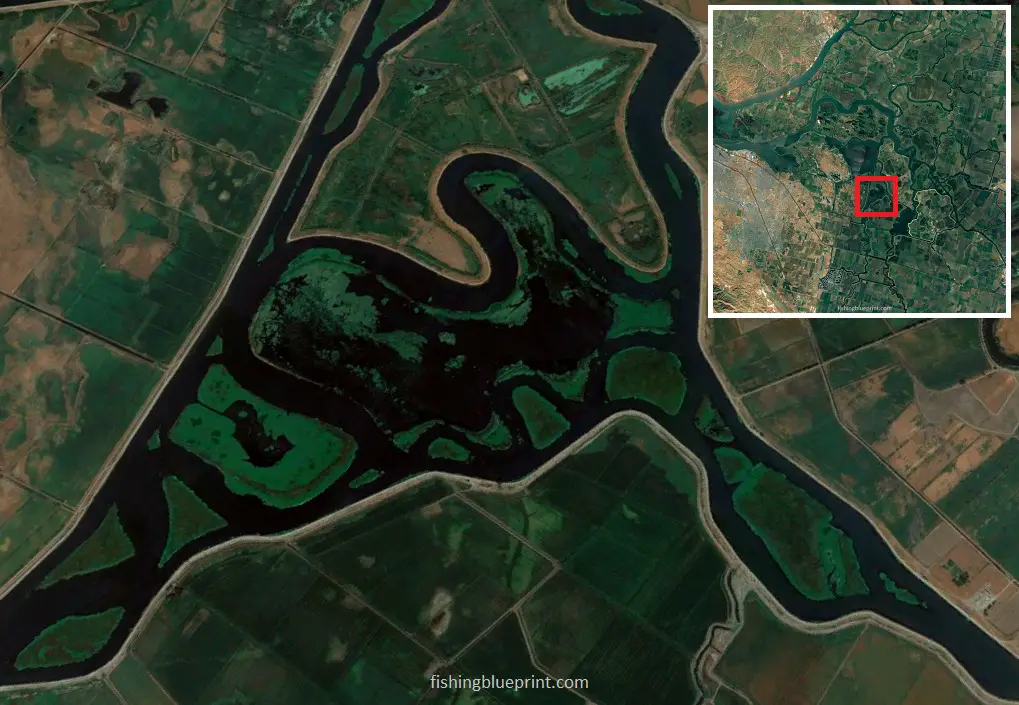
Fishing Little Mandeville Island is a little lesser known fishing spot on the California Delta.
Here are some tips to help you fish Little Mandeville Island effectively:
Look for weed beds and submerged brush: This area is known for its abundant weed beds and submerged brush and can be great places to target bass and even crappie. Fish along the edges of the weed beds, where the weeds are thickest, and pick apart any brush piles you come along.
Focus on sloughs: Many sloughs that can hold good concentrations of bass. Fish along the edges of the sloughs, especially where they meet the weed beds, and keep an eye out for any underwater structure, such as rocks or logs.
Look carefully at this spot with the topographic map…
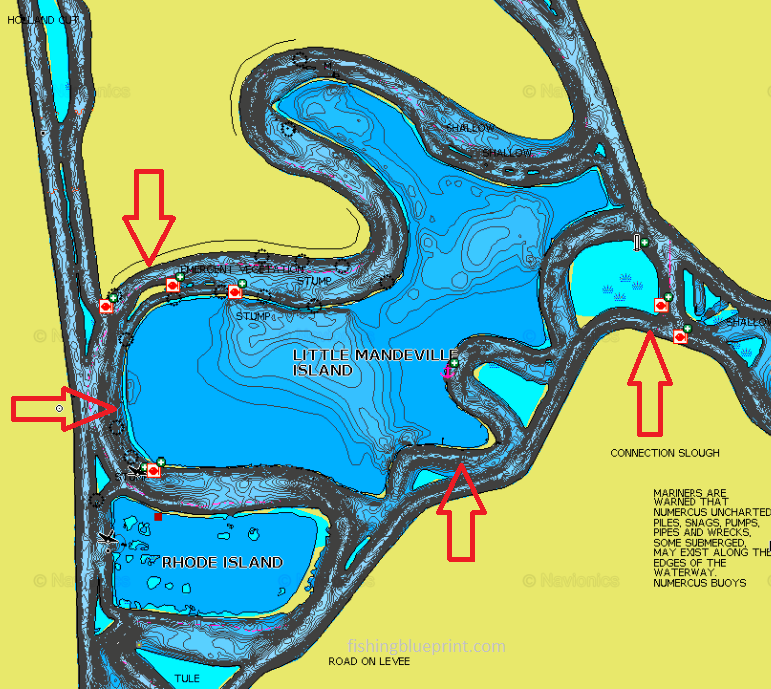
Use topwater lures: This can be a great place to fish topwater lures, such as poppers or walking baits, especially during the low light hours of dawn and dusk. The shallow waters and abundant weed beds can make for exciting topwater action.
Try finesse techniques: During periods of high pressure or clear water, the bass can become wary, and finesse techniques, such as fishing a Senko worm, using a drop shot, or shaking a wacky rigged can help you hook into some lunkers.
Pay attention to tides: This area is also affected by the tides, and the water level can fluctuate significantly. Pay attention to the tides and adjust your fishing tactics accordingly. For example, during high tide, the sloughs may be more productive, while during low tide, the shallower weed beds may be more active.
Structural features: grass, sloughs/drop offs/ ledges, humps, laydowns.
Best species to target: largemouth bass, crappie
Most effective way to fish this spot: flipping, swimbaits, crankbaits, topwater baits, frogs, poppers, buzzbaits, Senko, wacky rig, drop shot
Mildred Island

Fishing Mildred Island is a little lesser known fishing spot on the California Delta.
Here are some tips to help you fish this area effectively:
Look for weed beds: This area is known for its abundant weed beds, and these areas can be great places to target bass. Fish along the edges of the weed beds and look for areas where the weeds are thickest.
Focus on sloughs: Many sloughs that can hold good concentrations of largemouth bass, smallmouth bass, and striped bass. Fish along the edges of the sloughs, especially where they meet the weed beds, and keep an eye out for any underwater structure, such as rocks or logs.
Look carefully at this spot with the topographic map…
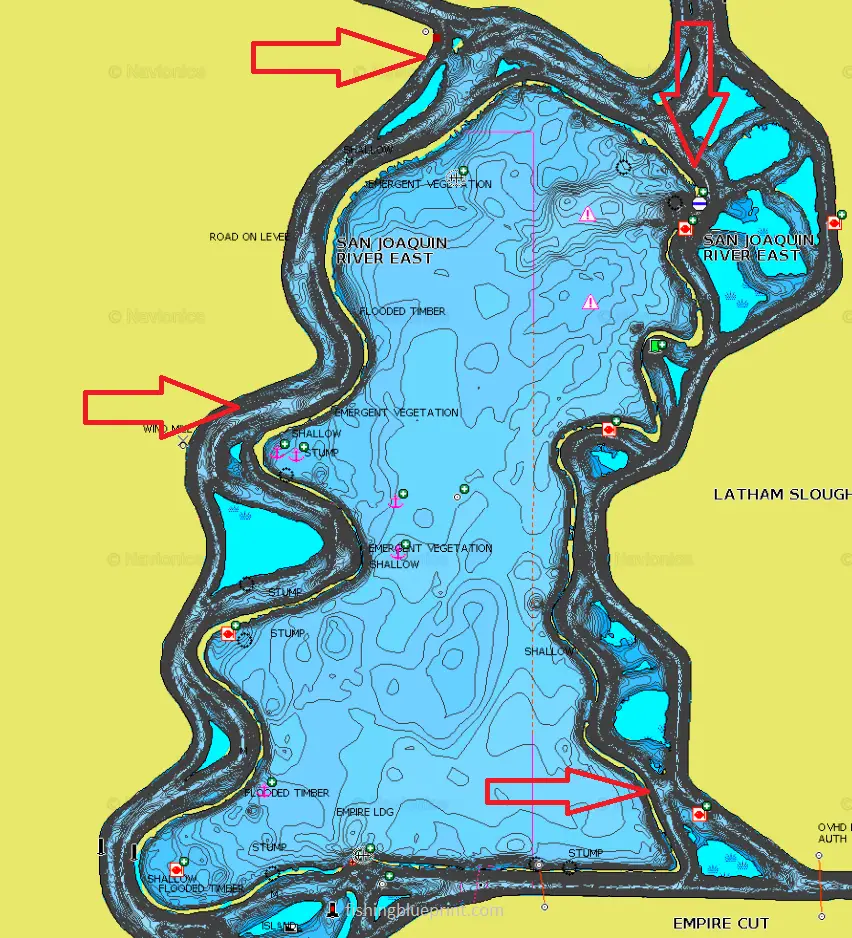
Use topwater lures: This can be a great place to fish topwater lures, such as frogs, poppers, buzzbaits, and walking baits, especially during the low light hours of dawn and dusk. The shallow waters and abundant weed beds can make for exciting topwater action.
Try finesse techniques: During periods of high pressure or clear water, the bass can become wary, and finesse techniques, such as fishing a Senko worm, using a drop shot, or shaking a wacky rigged can help you hook into some lunkers.
Pay attention to tides: This area is also affected by the tides, and the water level can fluctuate significantly. Pay attention to the tides and adjust your fishing tactics accordingly. For example, during high tide, the sloughs may be more productive, while during low tide, the shallower weed beds may be more active.
Structural features: grass, sloughs/drop offs/ ledges, humps, laydowns.
Best species to target: largemouth bass, smallmouth bass, and striped bass
Most effective way to fish this spot: flipping, swimbaits, crankbaits, topwater baits, frogs, poppers, buzzbaits, Senko, wacky rig, drop shot
Medford Island

Medford Island is another popular fishing destination on the California Delta for all species of bass and crappie.
Here are some tips to help you fish Big Break effectively:
Focus on structure: Medford Island is known for its abundant underwater structure, such as rocks, boulders, and riprap banks. Fish along these structures and look for areas where the bass might be holding.
Look carefully at this spot with the topographic map…
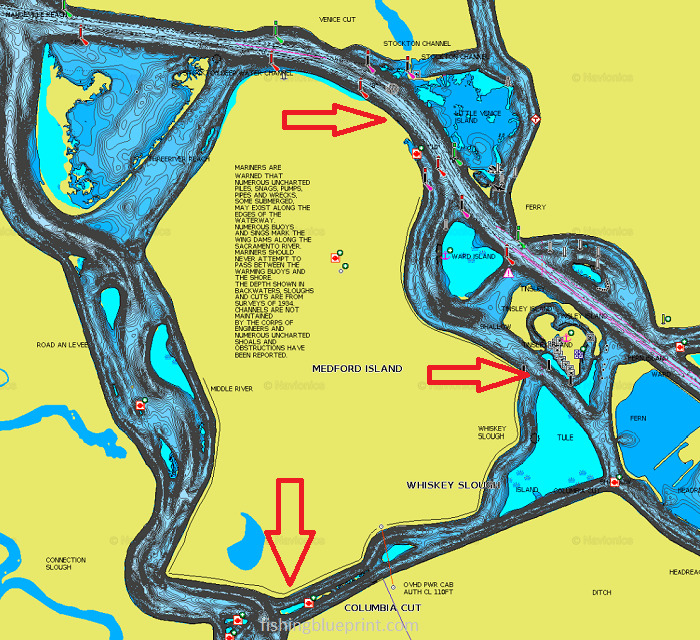
Use crankbaits: Medford Island has deep waters at the mouth and along the adjacent San Joaquin River as well as the multiple ox-bows to the east of the island… so deep-diving crankbaits can be an great way to reach the deeper areas where the bass might be holding. Target the drop-offs and deeper channels with these lures.
Shallow diving crankbaits and lipless crankbaits are effective in the shallow areas with grass.
Go with flipping lures: During periods of high tide bass will hide under the vegetation mats. Flipping a creature bait along the edges, or punching the large mats deeper in the thickest/ greenest vegetation can be the ticket to catching a huge bass.
Try jigs or worms: Jigs or worms fished along the bottom can be effective in the deep waters of Big Break. Pay attention to any underwater structure and fish these baits in and around these areas.
Pay attention to tides: Big Break is affected by the tides, and the water level can fluctuate significantly. Pay attention to the tides and adjust your fishing tactics accordingly. For example, during high tide, the deeper areas may be more productive, while during low tide, the shallower areas may be more active.
Look for baitfish: Pay attention to any signs of baitfish activity, such as birds diving or schools of baitfish on the surface. The bass will often be feeding on these baitfish, so fishing in these areas can be productive.
Structural features: grass, rocky banks/riprap banks, humps.
Best species to target: largemouth bass
Most effective way to fish this spot: flipping, swimbaits, crankbaits, topwater baits, frogs, poppers, buzzbaits, Senko, wacky rig, drop shot
Discovery Bay

Discovery Bay is an off-the-beaten-path area to fish. It’s a small community that features several intersecting channels that are lined with boat docks.
Don’t let the narrow channels fool you, some of them will be 15-20 feet deep! Needless to say largemouth, smallmouth, and striped bass are frequently caught here, especially during the winter and spring.
Here’s a few ways you can fish this area effectively:
Look for shady spots: Boat docks provide shade, and bass will often use the cooler, shadier areas as ambush points. Look for docks that have overhanging trees or other shading structures, and fish along these shadier areas.
Focus on the structure: Boat docks often have pilings, ropes, or other types of structure that can hold bass and other species. Pay close attention to these structures and fish along them, as well as around them.
Look carefully at this spot with the topographic map…

Use jigs or worms: Jigs or worms fished along the bottom can be effective when fishing around boat docks. Pay attention to any underwater structure and fish these baits in and around these areas.
Try topwater lures: During the low light hours of dawn and dusk, or when there is calm water, boat docks can be a great place to fish topwater lures, such as poppers or walking baits. The bass will often be feeding on the surface during these conditions, and topwater lures can be an exciting way to target them.
Pay attention to the tides: Boat docks can be affected by the tides, and the water level can fluctuate significantly. Pay attention to the tides and adjust your fishing tactics accordingly. For example, during high tide, the deeper areas around the docks may be more productive, while during low tide, the shallower areas may be more active.
Boat Ramps at The California Delta
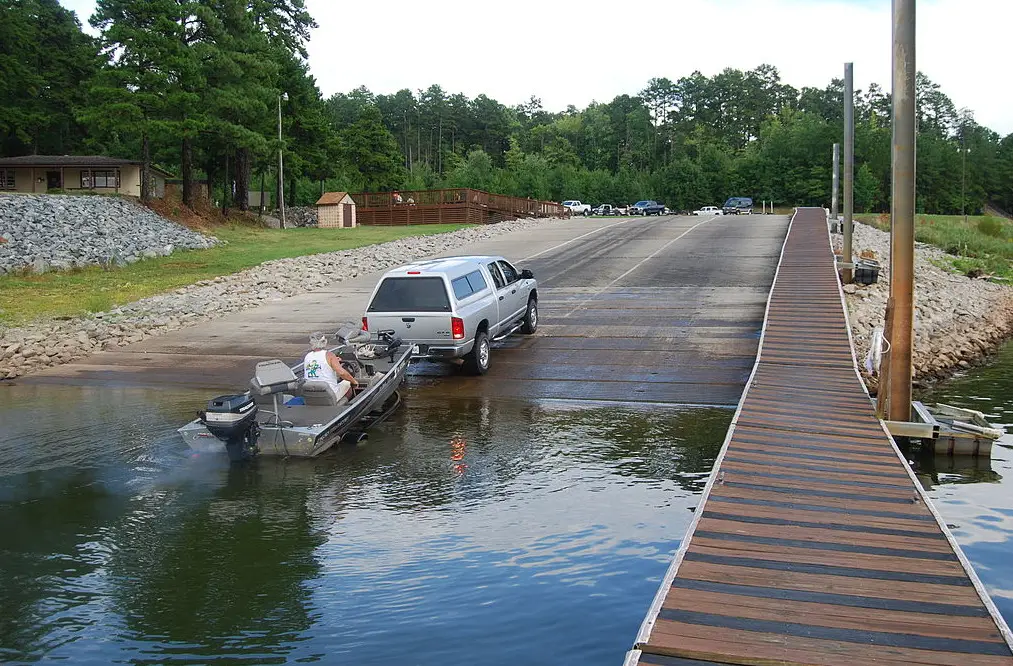
Pittsburg Public Boat Ramp
Cutter Ave, Pittsburg, CA 94565
Rio Vista Public Boat Launch
1 Main St, Rio Vista, CA 94571
Russo’s Marina
3995 Willow Rd, Bethel Island, CA 94511
(925) 684-2024
Whiskey Slough
3401 S Whiskey Slough Rd, Holt, CA 95234
whiskeyslough.com
(925) 595-0574
Buckley Cove Boat Launch/Lads
4911 Buckley Cove Way Stockton, California 95219.
(209) 937-8539
Paradise Point on the Delta
8095 N Rio Blanco Rd, Stockton, CA 95219
paradisemarina.com
(209) 952-1000
B & W Resort Marina & Boat Launch
964 Brannan Island Rd, Isleton, CA 95641
bandwresort.com
(916) 777-6161
Korths Pirates Lair
169 W Brannan Island Rd, Isleton, CA 95641
korthsmarina.com
(916) 777-6464
Rivers End Launch, Marina & Storage
6020 Lindemann Rd, Byron, CA 94505
riversendmarina.com
(209) 835-8365
Tracy Oasis Marina Resort
12450 Grimes Rd, Tracy, CA 95304
tracyoasismarina.com
(209) 835-3182
California Delta Marinas
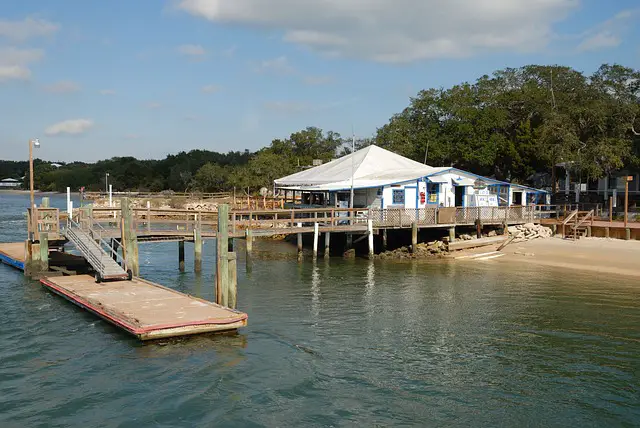
Antioch Marina Harbor
1 Marina Plz, Antioch, CA 94509
(925) 779-6957
Pittsburg Marina
51 Marina Blvd, Pittsburg, CA 94565
(925) 439-4958
Driftwood Marina
6338 Bridgehead Rd, Oakley, CA 94561
(925) 757-9449
Delta Loop
17645 CA-160, Rio Vista, CA 94571
(916) 777-6161
Delta Marina Yacht Harbor
100 Marina Dr, Rio Vista, CA 94571
(707) 374-2315
Lauritzen Yacht Harbor
115 Lauritzen Ln, Oakley, CA 94561
(925) 757-1916
Owl Harbor
1550 W Twitchell Island Rd, Isleton, CA 95641
(916) 777-6055
Delta Bay Marina
950 W Brannan Island Rd, Isleton, CA 95641
(916) 777-4153
Hidden Harbor Marina
3100 E Ryer Rd, Walnut Grove, CA 95690
(916) 775-1313
Willow Berm Marina
140 Brannan Island Rd, Isleton, CA 95641
(916) 777-6313
Ox Bow Marina
100 Oxbow Marina Dr, Isleton, CA 95641
(916) 777-6060
Big Break Marina
100 Big Break Rd, Oakley, CA 94561
(925) 679-0900
California Delta Tackle Shops
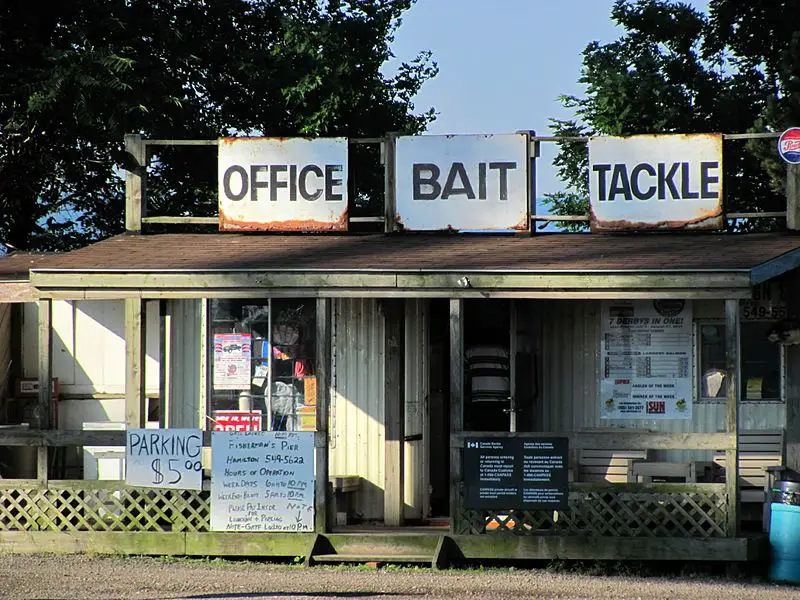
H & R Bait & Tackle
1850 W Charter Way, Stockton, CA 95206
(209) 463-1938
Mega Bait and Tackle
261 W Louise Ave, Manteca, CA 95336
(209) 665-7613
Fisherman’s Friend
440 E Kettleman Ln # A, Lodi, CA 95240
(209) 369-0204
The Bass Hole
6277 Bethel Island Rd Suite E, Bethel Island, CA 94511
(925) 813-9485
Hook, Line & Sinker
3100 Main St #260, Oakley, CA 94561
(925) 625-2441
Gotcha Bait & Tackle, Inc.
3500 E 18th St, Antioch, CA 94509
(925) 706-7400
Fishermen’s Catch Bait & Tackle
27 Marina Blvd, Pittsburg, CA 94565
(925) 267-2535
Lost Anchor Bait & Tackle
1001 Mc Avoy Rd, Bay Point, CA 94565
(925) 458-1717
Rio Vista Bait & Tackle
510 CA-12, Rio Vista, CA 94571
(707) 374-5522
Bob’s Bait Shop
302 2nd St, Isleton, CA 95641
(916) 777-6666
Marina Bait & Tackle 503 Marina Center Suisun City
503 Marina Center, Suisun City, CA 94585
(707) 389-2335
Virgil’s Bait Shop
201 Main St, Suisun City, CA 94585
(707) 425-5518
In Summary...
As you now can see fishing the California Delta can be tough at times, but it’s not impossible and with the help of the California Delta Fishing Report… It definitely helps you get started on the right foot quickly and easily, so you can avoid wasting hours wondering where and how to get started.
Did You Get All This?
As fellow fisherman and content creator I thrive on helping others… I feel like I can do the most good by helping others… And frankly… I would feel like I did something wrong if you didn’t walk away feeling a little better about this lake.
I truly want to over deliver for you…
So Let Me Ask You Another Question…
After reading this helpful report:
- Can you see how this could change the way you would fish this lake?… To make it easier, faster… and… with less headache, less frustration?
- If nothing else, do you now have a better sense of where you can get started, even if you have have been here?
- Do you feel that you have a good grasp of what species to expect in this lake?
- Do you have a good understanding what baits are needed to catch each of the different species of fish?
- Earlier we came up with some helpful spots to catch more fish, can you see yourself considering any one of those spots? Which ones are you the most excited about implementing when you get to the lake?
- Is it fair to say that using these spots would give you a significant advantage over someone else who’s fishing this lake?
I Need To Ask A Favor From You And It’s Not Going To Cost You A Single Dime…
If you have gotten anything out of this free report; whether its knowing where to get started, what kinds of fish are in this lake, what baits to use, where to launch your boat, where to buy a frosty beverage, where to camp, and other things to do when you’re at this lake…
Then I need you to do something that is going to help you your fellow angler…
And that is share this report. Please share it to as many people as you can. It’s free to you and it really helps me out as a creator.
Lastly… thank you for spending your time reading through this report and I hope you have a luck on the water.
THIS IS WHERE YOU CAN HELP ME THE MOST: There’s a lot of information about this subject you have found helpful, and I’m sure you’ll be able to put some of the knowledge bombs to use. But sharing this report helps drive traffic which in turn helps me at absolutely no cost to you. I love creating reports like this for you, and you like reading these types of reports please share this with your friends, family, and fellow anglers.
Click on your favorite social media buttons to share this page now!
Other California Related Fishing Articles
- Bass Lake Fishing Report
- Clear Lake Fishing Report
- Castaic Lake Fishing Report
- California Delta Fishing Report
- Diamond Valley Lake Fishing Report
- Don Pedro Reservoir Fishing Report
- Eagle Lake Fishing Report
- El Capitan Reservoir Fishing Report
- Lake Berryessa Fishing Report
- Big Bear Lake Fishing Report
- Folsom Lake Fishing Report
- Irvine Lake Fishing Report
- Lake Almanor Fishing Report
- Lake Camanche Fishing Report
- Lake Isabella Fishing Report
- Lake Havasu Fishing Report
- Lake McClure Fishing Report
- Lake Oroville Fishing Report
- Lake Perris Fishing Report
- Lake Piru Fishing Report
- Lake Skinner Fishing Report
- Lake Tahoe Fishing Report
- Los Banos Reservoir Fishing Report
- New Hogan Lake Fishing Report
- New Melones Lake Fishing Report
- O’Neill Forebay Fishing Report
- Pardee Lake Fishing Report
- Pyramid Lake Fishing Report
- San Luis Reservoir Fishing Report
- San Vicente Reservoir Fishing Report
- Shasta Lake Fishing Report
- Silverwood Lake Fishing Report
- Trinity Lake Fishing Report
- Whiskeytown Lake Fishing Report
More articles just for you...
Funny Fishing Rules, Laws, and Regulations 2025
Crazy Fishing Laws That Will Blow Your Mind! #7 is INSANE! Strange Fishing Regulations and Laws As silly as hook and rod limits may seem,
EXPOSED! How To Use A Spinnerbait The Right Way for 2025
Are You Wondering How To Use A Spinnerbait? Or How To Work A Spinnerbait Over Grass, Logs, or Points? Well, All These Questions Are Answered
EXPOSED! Best Crankbait Colors for 2025 [Which to Buy & Avoid]
What color crankbait to use? Crankbait Color Chart I just love going into a Bass Pro Shops store and just staring at all the walls
Best Underwater Dock Lights For Fishing – 2025 Buyers Guide
Night Dock Light Fishing For Beginners Dear fellow angler, Does this sound like you? You’re someone who loves fishing but just wants to escape the
15 Best Deep Diving Crankbaits [2025 Buyers Guide – Which to Buy & Avoid]
A Complete Buyer’s Blueprint On The Best Deep Diving Crankbaits for Bass, Walleye, or Striped Bass On The Market Today Fishing deep diving crankbaits can

